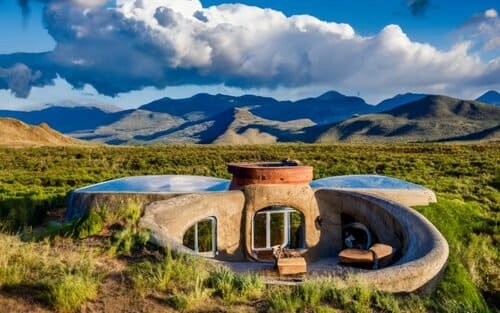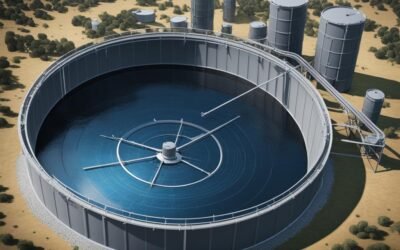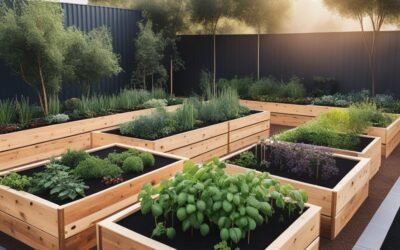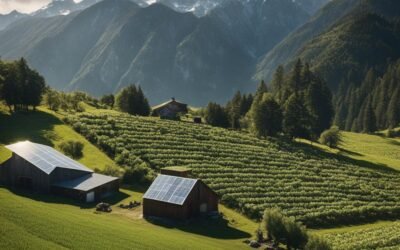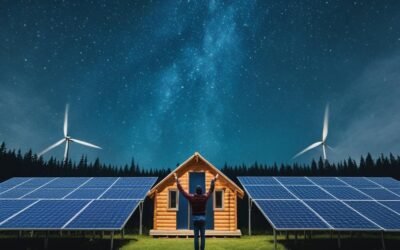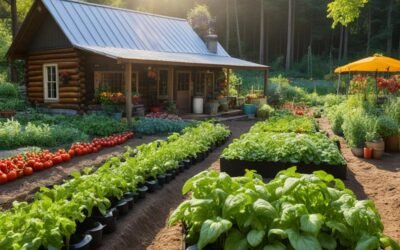Looking for a way to live sustainably, embrace eco-friendly construction, and enjoy off-grid living? Building an earthship might be the perfect solution for you. Earthships are innovative and self-sustainable homes that utilize recycled and natural materials for construction, making them both environmentally friendly and energy-efficient.
In this guide, I will take you through the process of building your own earthship, from the history and design to the construction materials and power production. You’ll discover alternative building techniques, learn about sustainable architecture, and explore the world of renewable materials. Let’s embark on this green adventure together and create a greener future.
Key Takeaways:
- Earthships are sustainable and self-sustainable homes that use recycled and natural materials.
- They are designed to be off-grid, collecting their own water and producing their own electricity.
- Michael Reynolds introduced the concept of earthships in 1971, and they have been growing in popularity ever since.
- Construction involves site selection, excavation, choosing the right materials, and creating the foundation, walls, and roof.
- Earthships rely on renewable energy sources like solar panels and wind turbines for power, and harvest and filter water from natural sources.
With a growing understanding of the importance of sustainable living and the benefits of off-grid lifestyles, earthship construction has gained momentum worldwide. Are you ready to join the green building revolution and construct your own earthship? Let’s get started!
What is an Earthship?
Earthships are sustainable houses constructed using recycled and natural building materials, such as used tires and cans. These homes are designed to be self-sustainable and do not require external sources for operation, like grid electricity. Earthships collect their own drinking water, produce their own electricity through wind or solar power, treat their own sewage, and sometimes even allow homeowners to grow their own food. These houses are typically built off-grid in remote locations, where conventional facilities are not readily available. Currently, there are approximately 3,000 complete earthships worldwide.
Earthships serve as models for sustainable housing by utilizing recycled materials and promoting self-sustainability. The use of recycled materials, such as tires and cans, reduces waste and helps preserve the environment. Additionally, being self-sustainable allows earthship homeowners to live off the grid, reducing their reliance on traditional utilities and minimizing their carbon footprint.
Benefits of Earthships
- Minimal reliance on external resources
- Reduced carbon footprint
- Utilization of recycled materials
- Self-sufficiency in power, water, and food production
- Lower operating costs
Earthships are not only environmentally friendly but also provide unique living experiences. These homes offer a sense of self-sufficiency and autonomy, allowing individuals to connect with nature and adopt a more sustainable lifestyle. By implementing renewable energy systems, water harvesting methods, and sustainable waste management practices, earthship owners contribute to a greener future.
Living in an earthship is like living in harmony with nature. It’s a beautiful blend of sustainable living, innovation, and a deep sense of connection to the environment.
Given their versatility and adaptability to different climates, earthships have gained recognition worldwide. These sustainable homes have been constructed in various countries, demonstrating their viability in different environmental conditions.
Earthship Construction Around the World
| Country | Number of Earthships |
|---|---|
| France | 250 |
| Germany | 500 |
| Mexico | 800 |
| Canada | 200 |
| United States | 1,250 |
These numbers represent completed earthships and highlight the global adoption of this sustainable housing solution. From Europe to North America, earthships are transforming the way we perceive housing and leading the way towards a more eco-friendly future.
To learn more about the history of earthships and the specific construction and design techniques involved, continue reading the following sections.
The History of Earthships
 The concept of earthships was first described by Michael Reynolds in 1971, and the first modern earthship was constructed by him in 1988 in Taos, New Mexico.
The concept of earthships was first described by Michael Reynolds in 1971, and the first modern earthship was constructed by him in 1988 in Taos, New Mexico.
“I believe that something good is going to happen here.” – Michael Reynolds
During a time when environmentalism was gaining momentum, Reynolds introduced the idea of sustainable and natural homes. He envisioned a future where individuals could live in harmony with the environment, minimizing their impact on the planet.
Earthships were born as a response to the environmental degradation caused by conventional building practices. Reynolds saw the need for a change and aimed to create homes that operated off-grid, utilizing renewable resources and recycled materials.
While some people believe that earthships are becoming outdated, they are actually growing in popularity as more individuals become aware of the impact of conventional lifestyles on the environment.
Building a Sustainable Future
Michael Reynolds played a significant role in pioneering sustainable practices and green building innovations. His dedication to finding alternative solutions for construction has inspired many to rethink their approach to housing.
- Reynolds advocated for the use of recycled materials, such as tires and cans, in earthship construction. By repurposing these items, the environmental impact of waste is reduced, and valuable resources are utilized.
- Earthships incorporate passive solar design principles, harnessing the sun’s energy to heat and light the homes naturally. This reduces the reliance on fossil fuels and minimizes greenhouse gas emissions.
- These homes prioritize water conservation through rainwater harvesting and greywater systems, ensuring a sustainable and efficient use of this precious resource.
- By implementing renewable energy sources like solar panels and wind turbines, earthships strive to be self-sustainable, reducing reliance on external power grids and promoting a more eco-friendly lifestyle.
While not everyone opts for a complete earthship home, many individuals choose to incorporate sustainable practices and green building innovations into their construction projects. This gradual shift towards more eco-friendly building methods is a positive step in the fight against climate change and environmental degradation.
| Key Points: |
|---|
| Earthships were first described by Michael Reynolds in 1971. |
| The first modern earthship was constructed by Reynolds in 1988 in Taos, New Mexico. |
| Earthships incorporate sustainable practices and green building innovations to reduce environmental degradation. |
| Reynolds’ vision has inspired individuals to incorporate sustainable practices into their construction projects. |
Construction and Design of an Earthship
 Building an earthship involves several key steps that contribute to its unique and sustainable design. From site selection and excavation to the construction of various components, each step is crucial in creating an eco-friendly and self-sustainable home.
Building an earthship involves several key steps that contribute to its unique and sustainable design. From site selection and excavation to the construction of various components, each step is crucial in creating an eco-friendly and self-sustainable home.
Site Selection and Excavation
When selecting a site for your earthship, consider the sun angle and direction to optimize solar heat and light. This will help maximize energy efficiency and create a comfortable living environment. Excavation depth will depend on the weather conditions and the desired size of your home. Adequate excavation ensures stability and proper insulation.
Selection of Construction Materials
Choosing the right construction materials is essential for building a durable and eco-friendly earthship. The materials should be readily available, cost-effective, and suitable for the local climate. Opt for recycled and renewable materials whenever possible to minimize environmental impact and promote sustainability.
Foundation and Outer Walls
The foundation of an earthship is typically created using tires filled with earth. This unique approach ensures stability and thermal mass, helping to regulate indoor temperatures. Additionally, the tires act as a sustainable solution for reducing waste. The outer walls can be constructed using recycled cans or bottles, providing insulation and contributing to the eco-friendly nature of the home.
Inner Walls and Roofing
To build the inner walls of an earthship, various techniques can be employed, such as using recycled cans or utilizing cob, a material made from a mixture of clay, sand, and straw. These materials provide thermal mass and insulation properties, maintaining a comfortable indoor temperature throughout the year. The roofing system typically consists of trusses, which can be filled with sustainable materials like dried grass or even recycled tin cans.
| Key Construction Steps | Materials Used |
|---|---|
| Site Selection and Excavation | Depends on location and weather conditions |
| Foundation | Tires filled with earth |
| Outer Walls | Recycled cans or bottles |
| Inner Walls | Recycled cans or cob (clay, sand, and straw) |
| Roofing | Trusses filled with dried grass or recycled tin cans |
By following these construction and design principles, you can create an earthship that not only promotes sustainable living but also provides a comfortable and self-sustainable space. Each component plays a vital role in ensuring energy efficiency and reducing the overall ecological footprint of the home.
Power and Water Production in an Earthship
 When it comes to sustainable living, an earthship is a prime example of harnessing renewable energy and utilizing water resources efficiently. In this section, we will explore how an earthship generates power through renewable sources like solar panels and wind turbines, while also harvesting and filtering water for everyday use.
When it comes to sustainable living, an earthship is a prime example of harnessing renewable energy and utilizing water resources efficiently. In this section, we will explore how an earthship generates power through renewable sources like solar panels and wind turbines, while also harvesting and filtering water for everyday use.
Power Production
An earthship is designed to minimize its reliance on traditional power sources by utilizing renewable energy. Two common options for power generation in an earthship are solar panels and wind turbines.
Solar panels are an excellent choice for regions with abundant sunlight. They capture energy from the sun and convert it into electricity to power the appliances and systems within the earthship. By strategically positioning the solar panels on the roof or in open spaces, maximum sunlight exposure can be achieved.
Alternatively, wind turbines can be installed in areas with consistent wind flow. As the wind passes through the turbine, it rotates the blades, generating electricity through a generator. This power can then be stored and used as needed.
“Harnessing the power of the sun and wind allows me to reduce my carbon footprint and live sustainably.”
Water Production
An essential aspect of self-sustainability in an earthship is water production. These eco-friendly homes have systems in place to harvest rainwater or snow and convert it into a usable resource.
The shape of an earthship, with its sloping roof, directs water to a cistern for storage. Rainwater or melted snow is collected through gutters and downspouts, filtering out debris along the way. The collected water then undergoes filtration processes to ensure its safety for drinking and general use.
The process of water filtration involves removing impurities and contaminants. This can be achieved through various methods, such as sediment filters, activated carbon filters, or UV sterilization. Each filtration step ensures that the water meets the required quality standards.
| Filtration Method | Process |
|---|---|
| Sediment Filters | Removes large particles and sediment from the water. |
| Activated Carbon Filters | Reduces chlorine, odors, and organic compounds. |
| UV Sterilization | Kills bacteria, viruses, and other microorganisms using ultraviolet light. |
“Having access to clean and purified water is not only essential for my daily needs but contributes to my eco-friendly lifestyle.”
Incorporating renewable energy sources and efficient water production and filtration systems allows an earthship to operate off-grid and in harmony with the environment. By embracing these sustainable practices, earthship owners can reduce their carbon footprint while enjoying a self-sufficient and eco-friendly lifestyle.
Where are Earthships Used?
 Earthships have gained popularity worldwide and have been constructed in various locations across the globe, including France, Germany, Mexico, Canada, and the United States. These sustainable homes have captured the imagination of individuals seeking a self-sustainable and eco-friendly lifestyle in different climates and environments.
Earthships have gained popularity worldwide and have been constructed in various locations across the globe, including France, Germany, Mexico, Canada, and the United States. These sustainable homes have captured the imagination of individuals seeking a self-sustainable and eco-friendly lifestyle in different climates and environments.
The construction of earthships differs based on their specific models. Let’s take a look at some of the global earthship models and their unique features:
- Global Model: The Global Model is designed to perform well in any climate. It incorporates a double layer of glass, underground cooling tubes, and convection skylights for natural ventilation and air conditioning. This model allows for maximum comfort and energy efficiency.
- Encounter: The Encounter model has a unique design that maximizes passive solar heating and natural lighting. It features a large greenhouse area that provides additional space for growing food and plants.
- Unity: The Unity model emphasizes simplicity and affordability. It is an ideal option for those looking for a smaller earthship design and a more budget-friendly approach to sustainable living.
- Refuge: The Refuge model is specifically designed for extreme climates and challenging environmental conditions. It incorporates extra insulation, thicker walls, and other features to ensure the comfort and safety of its inhabitants.
These diverse earthship models allow individuals to choose the design that best fits their needs and preferences, while still promoting sustainable living and self-sufficiency.
“The diverse range of earthship models enables individuals to find the perfect sustainable home design that suits their specific needs and aligns with their environmental values.” – Me
Conclusion
Building an earthship offers a unique opportunity to embrace sustainable living and create a self-sustainable home. By using recycled and natural materials for construction, harnessing renewable energy sources, and implementing water harvesting and filtration systems, earthships provide a greener alternative to conventional homes.
With the growing awareness of environmental issues and the benefits of off-grid living, earthship construction and design are becoming more popular worldwide. People are realizing the importance of reducing their carbon footprint and living in harmony with nature. Earthships not only provide a sustainable living solution but also embrace innovative green building practices.
Embrace the green revolution and take the first steps towards building your own earthship for a sustainable and eco-friendly lifestyle. Join the community of individuals who have chosen to live in eco-friendly homes, reconnect with nature, and make positive changes one earthship at a time. Together, we can create a better future by living in harmony with our planet.
FAQ
What is an earthship?
An earthship is a sustainable house constructed using recycled and natural building materials, such as used tires and cans. These homes are designed to be self-sustainable and do not require external sources for operation, like grid electricity.
How do earthships contribute to sustainable living?
Earthships contribute to sustainable living by collecting their own drinking water, producing their own electricity through renewable energy sources, treating their own sewage, and sometimes even allowing homeowners to grow their own food. These houses are typically built off-grid in remote locations.
Who first introduced the concept of earthships?
The concept of earthships was first described by Michael Reynolds in 1971. He introduced the idea of sustainable and natural homes at a time when environmentalism was gaining momentum.
Are earthships still popular today?
Yes, earthships are growing in popularity as more individuals become aware of environmental degradation and the impact of conventional lifestyles. Many people choose to incorporate sustainable practices and green building innovations into their construction projects.
What are the key steps in building an earthship?
The key steps in building an earthship include site selection and excavation, selection of construction materials, construction of the foundation and outer walls, construction of the inner walls, and roofing.
How is power produced in an earthship?
Power production in an earthship is achieved through renewable energy sources such as solar panels or wind turbines. Deep cycle batteries are used to store the generated power.
How is water produced in an earthship?
Water production in an earthship involves harvesting and filtering water from natural sources like rain or snow. The shape of the house directs water to a cistern, which is then purified for safe and drinkable use.
Where are earthships used?
Earthships have been constructed in various locations around the world, including France, Germany, Mexico, Canada, and the United States. Different earthship models have been utilized in different climates and environments.




